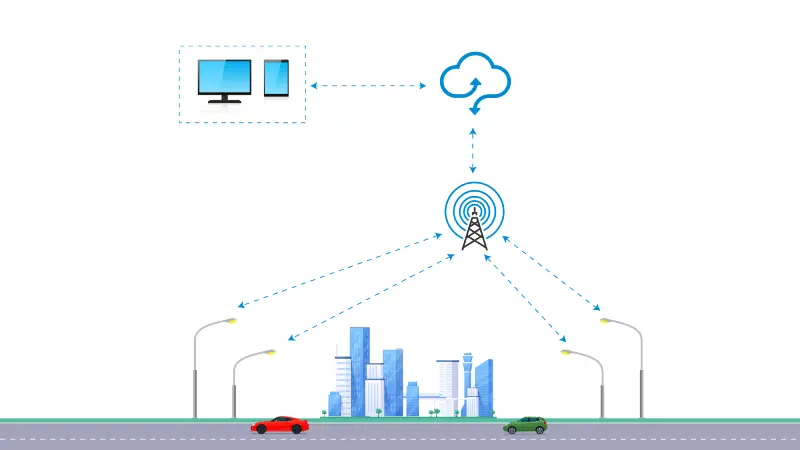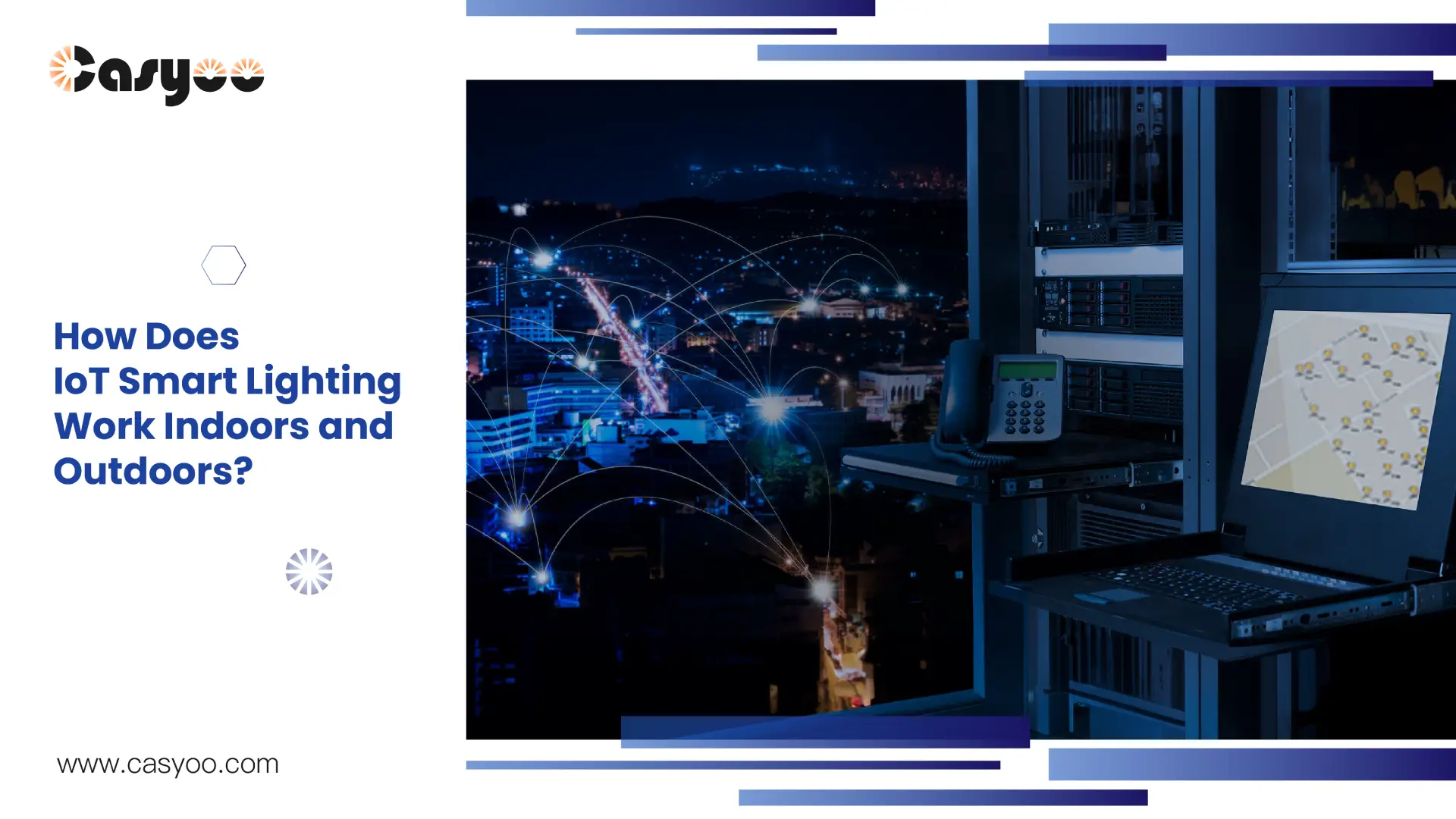IoT technology is widely used in production chains, logistics, agriculture, and other fields that are closely related to us, providing a convenient data management solution. It is significant in the field of lighting as well. Whether it is outdoor street lights or indoor home lighting and commercial lighting, IoT technology can turn it smarter. In the following passage, we will explain how IoT smart lighting works in indoor and outdoor settings. What are its functions and advantages? Read on to learn more!
What is smart lighting in IoT?
The Internet of Things refers to the networked connection of numerous smart devices to enable data interchange and intelligent control amongst them. This technology is put into use in lighting as people carry out smart home and smart city lighting plans to save energy. The IoT smart lighting system supports intelligent control, automated management, data collection, and analysis. It is estimated that by 2029, the scale of the smart iot market will further expand to US$39.91 billion, with a compound annual growth rate (CAGR) of 12.2%.
How does IOT smart lighting work?
The Internet of Things lighting consists of three parts: data collection and perception components, data transmission components, and management and control hosts. Data collection components in lamps generally include photoresistors, motion sensors, GPS systems with digital clocks, etc. Data transmission components include wireless communication modules installed in lamps, signal base stations required for certain communication methods, and cloud platforms. The management and control host is one or several terminals such as computers or mobile phones. The host can have various functional modules, such as a controller, a statistical analysis control module, a geography control module, an archive data control module, a setting control module, a communication module, etc.
Simply put, the process of controlling smart lamps through the Internet of Things is as follows:
- The sensors on the lamps collect information about the surrounding environment and the status of the lamps, such as light intensity and whether the street lights are faulty.
- The data in the sensor is sent to the wireless communication module in the lamps.
- The communication module sends the data to the cloud platform.
- The cloud platform automatically sends corresponding instructions to the lamps based on the received data and the preset program, such as reducing the brightness.
- The cloud platform also sends data to the control host, so that the operator can monitor the lamps in real time and send corresponding instructions.

Functions of IoT smart lighting
- Real-time detection and display of the online status of each device
- When the gateway device is offline, the host will receive a problem alert from the system. It can locate the specific location of the fault and report to the management personnel as soon as possible. This makes the equipment monitoring and fault diagnosis more convenient and controllable.
- The system can either control a single lighting circuit or groups of lights.
- With the smart IoT lighting system, the switch of the load (lamp) can be set to only turn on or off when the AC power passes through zero. This can effectively reduce electromagnetic interference and extend the life of the lamp.
- It supports precise dimming from 0% to 100%. For lights that start aging, the system can offer remote control of the compensation rate to keep their brightness constant.
- By presetting the local longitude and latitude information, the system can automatically calculate the sunrise and sunset times of each day. According to the astronomical clock, the lights will switch on at sunset and off at morning.
- When the host computer system fails or the module is offline, the driver module can use its own RTC clock to maintain the normal timing control.
Advantages of IoT smart lighting
- Energy saving: Smart lighting can improve energy efficiency at a low cost, and make lighting control more convenient and flexible at the same time. Roughly speaking, the system can save 30% to 50% of the energy.
- High reliability: Smart lighting solutions can provide essential data on energy use, lighting patterns and occupancy levels. In this way, operators can make accurate management and maintenance plans.
- Improve the experience of residents: Advanced lighting systems can create different lighting scenes for different activities, thereby greatly improving work comfort and productivity. A report by the University of Birmingham showed that lighting is one of the main factors affecting workplace comfort. Using the smart system can keep the lighting suitable and easy to adjust.
What is IoT street lighting?
- System Overview
In this article, we will talk about the smart street lighting system that uses the NB-IoT system. This system is a remote real-time monitoring system with a single lamp as the control unit. Under the premise of ensuring road lighting safety, the system adjusts the power of a single lamp at certain times to save energy and extend the service life of the lights. The street light monitoring system uses a geographic information system (GIS) to build an overall layout and integrates information such as lamp type, watt, etc. on GIS. The primary function of this system is to switch and dim the city street lighting, as well as to detect the real-time status of the lights.
- Economic benefits
Take a 3,000-meter double-row street lighting system as an example: the distance between the lamp poles is 30 meters. Each lamp pole is equipped with a 400W motor vehicle lighting lamp and a 250W non-motor vehicle lighting lamp. There are totally 200 lights on the road. The light-on time is 19:30, the light-off time is 7:00, and the total light-on time is 11.5 hours per day. After adopting intelligent street light control, the switch mode can be set arbitrarily. Here we calculate the power of the following modes:
Fully lit: 200×(400+250)=130000W=130KW.
Lighting up one side: 100×(400+250)=65000W=65KW.
Lighting up the 400W lamps on one side: 100×400=40000W=40KW.
When a single lamp 400W and 250W are cross-lit: 100×(400+250)/2=32500W=32. 5KW.
Lighting up the 250W lamps on one side: 100×250=25000W=25KW.
| Power (kW) | Power consumption (kWh) | ||
| Daily | Annual | ||
| Fully lit all night | 130 | 1495 | 550,000 |
| Fully lit for half of the night, and lighting up one side for the other | 130→65 | 1040 | 380,000 |
| Fully lit for half of the night, and lighting up the 250W lamps on one side for the other | 130→25 | 760 | 277,000 |
How is IoT used for indoor lighting?
When an IoT smart lighting system is used for indoor lighting, its structure is similar to that of outdoor lighting. However, compared with the long-distance communication protocols such as LoRaWAN and NB-IoT used for street lights, indoor lighting can also use short-distance communication methods such as zigbee with low latency. With this system, users can control the lights remotely with a mobile phone app, computer webpage, or software. The smart lighting management platform receives user instructions, processes data, and sends control signals. Smart lighting control terminals such as dimmers and sensors connect different types of lamps and perform corresponding operations. Common functions of indoor smart lighting are as follows:
Residential IoT smart lighting
- It provides personalized lighting solutions based on user age groups, settings, and required functions, such as scientific lighting for children’s rooms and elderly-friendly lighting for the elderly. The system also supports creating multiple modes to quickly change lights, such as sleep rhythm mode, reading mode, etc.
- When you are on vacation or out, you can use smart lighting to ensure the safety of your home. The lamps will automatically turn on and off at random within the set time to simulate the situation when the owner is at home.
- IoT technology can collect data from the lighting system, analyze, and process it. It can determine which areas need more lighting or modify the brightness and color temperature of the light based on different activities.
- You can remotely monitor and manage the lighting system as well as check the energy consumption and fault information at any time through a mobile phone app and other methods.
Commercial IoT smart lighting
- The system can automatically adjust the lighting level according to personal preferences. For example, the lighting can automatically dim or brighten according to the employee’s tasks or emotions to provide a more comfortable working environment.
- Lighting can serve as a way of defense to prevent unauthorized access. For example, when surveillance cameras detect suspicious activity, lighting can be programmed to activate in these areas.
- Intelligent systems can analyze data from IoT sensors and optimize lighting in real time. By analyzing historical usage patterns and other external factors, these systems can predict when and where lighting is most needed and adjust accordingly, further reducing unnecessary energy consumption.
Conclusion
IoT smart lighting systems combine data collection and analysis technology, data transmission technology, and management and control platforms to make lighting more convenient and flexible. When IoT smart lighting systems are used for street lighting, they can save 30%-50% of power consumption each year. When it is used for indoor lighting, it can provide various lighting modes. Using IoT smart lighting is a key step in lighting upgrades. If you are ready, contact Casyoo for the best recommendations for smart street lighting and garden lighting fixtures!




